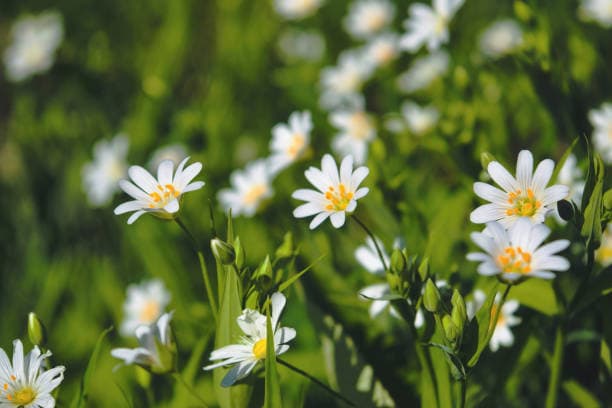
Scientific Name
Stellaria media
Common Names
Chickweed
Plant Family
Caryophyllaceae
Location
Native to Europe and now found nearly worldwide. Grows in gardens, lawns, woodland edges, and anywhere moist, cool, and shaded. A beloved weed of spring and fall.
Description
Low-growing, delicate annual with tiny white star-shaped flowers, succulent stems, and tender leaves. Creeps along the ground in patches. Fresh plant is juicy and bright, often forming a spring carpet in gardens.
Uses
A gentle but versatile herb, prized for its anti-inflammatory, antioxidant, antifungal, antibacterial, and analgesic properties, applied both internally and externally. As a soothing, demulcent plant, it helps ease inflammation in the digestive, respiratory, urinary, and integumentary (skin) systems, calming irritated mucous membranes and supporting healing. Its mild carminative and digestive effects can help relieve gas, bloating, constipation, and indigestion, while its nutritive content supports general vitality. Externally, it is often used to cool and soften inflamed or itchy skin, treat rashes, wounds, ulcers, and other surface irritations; the saponins and mucilage lend a smooth, protective feel. Chickweed also exhibits mild diuretic and vulnerary actions (promoting healing of damaged tissues) and has been used in traditional remedies for sore throat, cough, asthma, rheumatic pain, and conditions of excess heat (inflammation) in various organs. Though many of these uses stem from traditional or preclinical work, the accumulating phytochemical and pharmacological evidence upholds its reputation as a cooling and soothing herb for inflammation, infection, and digestive discomfort.
Energetics
Cooling, moistening, soothing. Great for dry, hot, inflamed tissues — inside and out.
Parts Used
Aerial parts (fresh preferred)
Constituents
Saponins, mucilage, flavonoids, minerals (calcium, magnesium, potassium), vitamins C and A
Dosage
- Fresh plant juice or poultice: For rashes, eczema, burns
- Infusion: 1–2 tsp fresh or dried herb per cup; steep 10–15 min
- Tincture (1:5): 20–40 drops, 2–3x/day
Notes on Use
Chickweed is loved for its simplicity and grace. It’s one of the first herbs that’s harvested in spring — gentle but potent for calming angry skin and cooling heat. Also makes a beautiful food herb — throw in salads or blend in pesto’s. It's a gift of renewal.
Harvesting
• Best fresh. Harvest in cool weather before flowering. Wash gently and use immediately or freeze as an infused oil or tincture.
Contraindications
Very safe. Mild laxative effect in large doses.
Recipes
- Itch-Relief Salve: Chickweed, calendula, plantain infused oil
- Spring Cleansing Tea: Chickweed, cleavers, nettle
- Cooling Eye Wash: Chickweed tea, strained and cooled